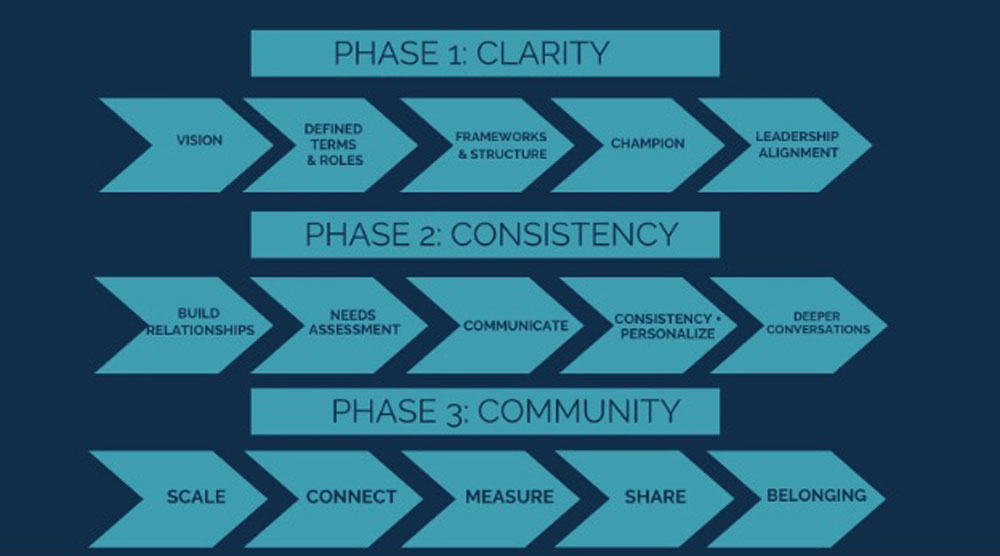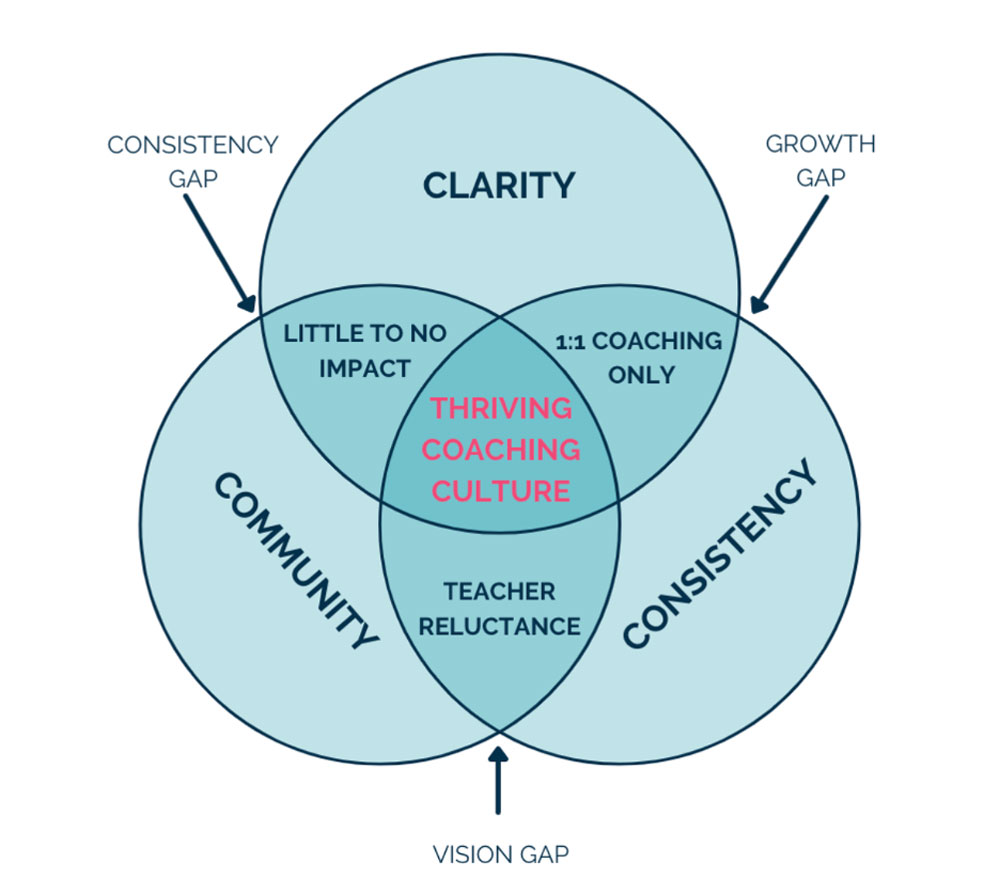
Based on conversations I’ve been having in workshops, webinars, with clients, and on the #coachbetter podcast, instructional coaching is on the rise in international schools. Our schools are committed to improving student learning, and one of the most impactful ways we can do that is through coaching (please see my previous article, Five Reasons Instructional Coaches are Essential in Schools for more details). Ultimately when teachers feel appreciated, valued, and respected in their work, it leads to “improved relationships, enhanced wellbeing, and improved teaching outcomes” (Howells & Cumming, 2012, p. 71). One of the best ways schools can support and show appreciation for teachers is to value their professional growth and provide them the support and time they need to be successful in their roles.
However, each international school is unique, based on its individual school community, host country culture, school governance, and structure; therefore, there is no one-size-fits-all model of instructional coaching that will work for every international school in every context. Through my work with clients over the past decade, I’ve developed a broad structure, called the Thrive Model (also grounded in the work of Joellen Killion, Cindy Harrison, Heather Clifton, Laura Lipton, and Bruce Wellman), that provides enough flexibility, and opportunity for customization, for each unique school community, while consistently leading to successful instructional coaching.
The Thrive Model (which is also used as the foundation for The Coach Certificate and Mentorship Program) follows three key phases:
 The Thrive Model for instructional coaching success. (Photo source: Kim Cofino, © 2023)
The Thrive Model for instructional coaching success. (Photo source: Kim Cofino, © 2023) 1: Clarity
Instructional coaching programs that are successful have clarity. With clarity comes purpose. Clarity allows us to define expectations, communicate, and implement the work based on the defined expectations, and then measure the results.
Schools need clarity in terms of:
The success of a coaching program relies on the intentionality behind the program. The purpose of coaching needs to be clearly articulated so that all stakeholders have an understanding of both why coaching is part of our school structures and systems and what coaches do. Defining coaching and aligning the actions of coaches and leaders to the vision of the program is the foundation of making coaching successful. When schools are defining the purpose and process of coaching, it needs to be aligned to the greater vision and mission of the school.
Laura Lipton notes that there needs to be “a vision of learning and growth that is identical for everyone in that organization. So whenever someone is called upon to serve in their role, it should be calibrated to the vision of learning and growth.” She recommends that as school leaders are developing a coaching program, they ask themselves, “To what degree does this align with the greater vision?” (Cofino, 2022c). This alignment can provide clarity in the work that coaches do, and in the structure of the coaching program.
Taking the time to intentionally structure the coaching program so that it aligns with the school’s vision provides an essential foundation in building a coaching culture, which supports the work of coaches. Maggie Hos-McGrane points out, “People who move into a coaching role need clarity about what the job entails, and the people in the school need clarity, and the leadership need clarity. Sometimes this involves quite hard conversations with school leaders” (Cofino, 2022d). All of this requires a clear vision from the start.
Clarity in defining the role of coach, and what makes coaching successful, also makes it easier for schools to hire, and if needed, train coaches. When we have a clear definition of what coaching is, what coaches do, and what makes them successful, we can articulate that in job descriptions, the hiring process, and the evaluation process. Rather than assume that a potential coach has the “right personality” for the job, we can clearly define the structures that make the position successful and support the coach in reaching those goals. This is how we separate the act of coaching from the person doing the coaching.
Many of the challenges faced by instructional coaching in international schools might seem to be caused by things like teacher reluctance to participate, but this is very often simply the result of a lack of clarity in the development or communication of the program. As Joellen Killion says, “If I can describe it with specificity, it is far more likely to be achieved than if I don’t have the capacity to be specific. More time on the ‘what,’ and less time on the ‘how.’ We do that backwards in schools. We spend a lot of time on the ‘how’ without clarity on the ‘what’” (Cofino, 2022b). Spending time developing clarity around language and purpose before taking action is essential to the establishment of a successful coaching program.
2: Consistency
Consistency clarifies expectations. When you are able to implement coaching with consistency, you can demonstrate to teachers why they might want to opt-in to coaching with you.
A consistent program looks like:
Consistency in the implementation of a coaching model is the action of building trust in the coaching process. Although each coach will come to the school with their unique style, personality, and expertise, following a framework allows teachers to develop an understanding of the outcome of their time spent in coaching conversations.
For teachers to invest their time in coaching, they need to have a clear understanding of what to expect. As Diane Sweeney says, “Coaching needs to be consistent. Teachers need to know that there’s a predictable structure to this work” (Cofino, 2022a). Consistency in the coaching team ensures that teachers will have similar, although personalized, experiences, so they know what to expect when working with a coach. Personalized, consistent experiences enable teachers to recognize the value of coaching and to become comfortable with the process.
3: Community
Community grows culture. When coaches can begin to develop connections between teachers, to build capacity within the staff, they will build the foundations for a coaching culture. When schools create a culture of coaching, they are developing an environment where all educators are invested in their own professional growth and actively seek out coaching opportunities. This culture is sustained when school-supported structures and systems are implemented to create space, time, and respect for the coaching process.
A thriving coaching community looks like:
In her experience as middle school Assistant Principal at International School Panama, Kaitlyn Pettinga has realized that “the impact of coaching is a sense of belonging,” noting that her school culture is so collaborative around teaching and learning through the work of coaching that both teachers and students feel like they belong (Cofino, 2023b). Creating a safe space for teachers to explore, take risks, and be supported in their journey, along with a deep respect for the work that teachers and students are doing, develops a sense of collective efficacy and belonging.
It is often having a personal relationship with a coach, developed and sustained over time, that can make the difference for teachers seeking to turn inspiration into action in their classroom. “When we invest in coaches, we are investing in teachers” (Cofino, 2023a). Coaches can help teachers feel they have someone on their side who is dedicated to their professional growth, someone embedded in their workplace who helps empower them to take action, and someone who can individualize growth experiences for them so they can apply what they’re learning.
When coaches begin to leverage the work they do with individuals, teams, and groups, the culture of coaching spreads even more widely. Developing school wide structures that support coaching (through systems like prioritizing shared meeting times, bringing coaches into the curriculum review and planning process, and formalizing support for coaching through the schedule) are essential to sustaining a coaching culture over time.
Mind the Gap
It’s worth noting that most schools develop coaching programs organically, making progress on each of the three phases in the Thrive Model simultaneously, which can lead to potential gaps in program development.
When schools have a growth-minded community and consistency in coaching practice but a lack of clarity around the vision for coaching, this often results in teacher reluctance to participate in coaching, or a “vision gap.” When schools have consistency in practice and clarity in vision, but lack a growth-minded culture, this often leads to coaches working almost exclusively with the “willing” teachers and becoming stuck working at the individual (one-to-one) level, or a “growth gap.” When schools have clarity around coaching and a growth-minded culture, but a lack of consistency among coaches or coaching practice, this often results in little to no impact from coaching, or a “consistency gap.” These gaps can be closed through an audit of the coaching program that intentionally addresses the missing components in each phase of the Thrive Model.

Build the Foundation of a Thriving Coaching Culture
All schools with learning as their focus have the potential to build a thriving coaching culture. Bringing the three interdependent elements of clarity, consistency, and community into place one by one is the first step. If you are just beginning the journey to develop a coaching program, set yourself up for success by following the Thrive Model. If a coaching program exists in your school but you find yourself stuck in one of the “gaps,” you can use the Thrive Model to understand where you may need to place more attention and focus. Find all the resources at edurolearning.com/thrive.
References
Cofino, K. (Host). (2022a, January 12). How to Coach Reluctant Teachers with Diane Sweeney (144). [Audio podcast episode]. In #coachbetter. Eduro Learning. https://coachbetter.tv/episode-144/
Cofino, K. (Host). (2022b, January 26). What Makes Coaching Work with Joellen Killion (146). [Audio podcast episode]. In #coachbetter. Eduro Learning. https://coachbetter.tv/episode-146/
Cofino, K. (Host). (2022c, February 23). The Continuum of Practice for Instructional Coaches with Laura Lipton (150). [Audio podcast episode]. In #coachbetter. Eduro Learning. https://coachbetter.tv/episode-150/
Cofino, K. (Host). (2022d, October 4). The Essentials of Professional Learning with The Coach Mentors (174). [Audio podcast episode]. In #coachbetter. Eduro Learning. https://coachbetter.tv/episode-174/
Cofino, K. (2023a, February), When We Invest in Coaches, We Invest in Teachers. The Learning Professional, Tackling Turnover, 44(1) 26-29. https://learningforward.org/journal/tackling-turnover/
Cofino, K. (Host). (2023b, October 4). Creating a Positive School Culture Through Coaching with Kaitlyn Pettinga (215). [Audio podcast episode]. In #coachbetter. Eduro Learning. https://coachbetter.tv/episode-215/
Howells, K., & Cumming, J. (2012). Exploring the role of gratitude in the professional experience of pre-service teachers. Teaching Education 23(1), 71-88. https://www.tandfonline.com/doi/full/10.1080/10476210.2011.638370
--------------------------------------------------------------
Kim Cofino has been an educator in international schools since August 2000. Having lived and worked in Germany, Malaysia, Thailand, and Japan, Kim has had a variety of roles in international schools, including (her favorite) instructional coach. Now based in Bangkok, Thailand, Kim is the co-founder and CEO of Eduro Learning, which offers online customized professional development in a community-driven environment, including COETAIL, Women Who Lead, and The Coach Certificate & Mentorship programs. Kim is co-author of Your Connected Classroom: A Practical Guide for Teachers, as well as co-host of the #coachbetter podcast and YouTube series. Find out more about Kim at edurolearning.com.